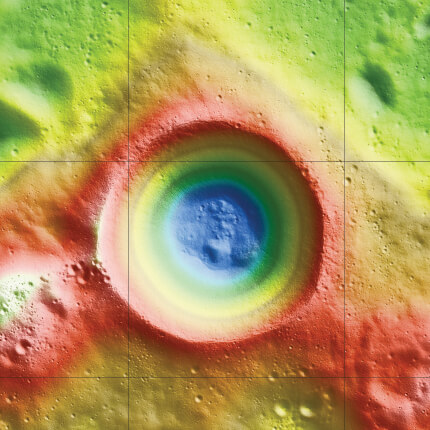Data launched by the spacecraft Lunar Orbiter Recognition – The moon patrol or LRO of NASA, show that ice may make up 22% of the material on the surface of Shackleton Crater at the south pole of the Moon.

The giant crater, named after Antarctic explorer Ernest Shackleton, is about 3 kilometers deep and about 18 kilometers in diameter. The slight inclination of the moon's axis means that the interior of Shackleton Crater is in perpetual darkness and is therefore also very cold. The researchers believed that it was possible that ice could accumulate there.
When the scientists used LRO's laser altimeter to study the floor of Shackleton Crater, they found that it was brighter than the floors of craters near the South Pole. This phenomenon usually indicates the presence of small amounts of light-reflecting ice preserved by the cold and darkness. The findings are published today in the journal Nature.
In addition to the possible evidence of ice, Shackleton's new map reveals a well-preserved crater that has remained stable since its formation over 3 billion years ago. The crater floor is dotted with several small craters, which were formed as part of the collision that created Shackleton.
"The face of the crater is very scarred," says Maria Zuber, the lead researcher in the study, from MIT. "It won't be easy to walk around there."
While the bottom of the crater was relatively bright, Zuber and her colleagues saw that its walls were even brighter. The finding will be exciting for the scientists who thought that if the ice is somewhere in the crater, it will be on the bottom, where no direct sunlight penetrates. The upper walls of Shackleton Crater are occasionally illuminated, which causes any ice that accumulates there to evaporate.
"The brightness measurements have been bothering us for two summers" says Gregory Newman from NASA's Goddard Center, and co-author of the article. The theory proposed by the researchers to explain the riddle is "moonquakes" shock waves from meteorite impacts or from the tides activated by the earth may cause the dark walls to collapse and reveal a bright and new ground beneath them. Zuber's team produced a high-resolution map that provides strong evidence of ice both at the bottom of the crater and on its walls.
"There may be many explanations for the bright observations all over the crater" says Zuber. "For example, new materials may be exposed along the walls while ice may be mixed with the bottom."

6 תגובות
Avi Shalom,
What happened with the "picture of the day"? Why was it discontinued?
Not more respectable and more serious to say about 20%???
Yehuda
I think that scientists are often a bit hasty in their conclusions, like the rest of us.
The problem is that there is often an impression of a lack of seriousness and responsibility, and therefore there are as if
Those who doubt the facts and findings presented by science.
And is that the water above the sky?
Dear Ernst, understand the reason
At distances of millions of light years and even a few single light years, you can say whatever you want and no one will be able to come and verify your words and you will always remain a possibility. But here on the moon you have to be careful!. Most likely in a relatively short time a space mission will be sent there to land and bring real findings. And no one will want to be humiliated
Good Day
Sabdarmish Yehuda
In bodies that are light years away from us, we "know" how to analyze their speed, material, climate, gravitational forces and the way and origin of their formation, and more, whereas here on the moon, it suddenly seems much, much more complex, and unclear..